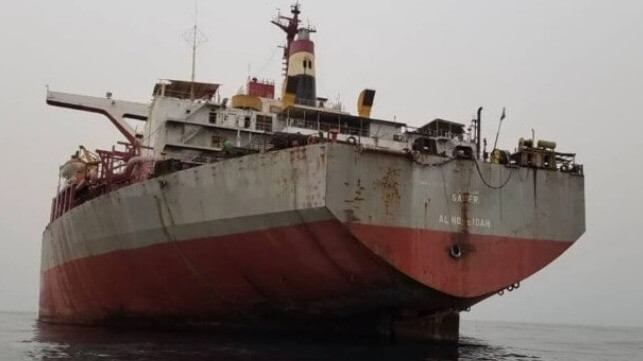IMO: Critical Gap in Safer Salvage Plan Needs Spill Response Equipment

An urgent call has gone out for the contribution of a broad range of equipment to manage an oil spill as the final stages of preparedness planning proceeds in advance of the salvage efforts to remove oil stored aboard the decaying FSO Safer. The International Maritime Organization is reporting that a “critical gap” has been identified in the precautionary efforts before the complex and inherently risky ship-to-ship transfer begins in May.
The IMO is providing expertise in oil spill preparedness and response as part of the contingency planning for a possible spill from the FSO Safer before the transfer operation gets underway. In a circular sent to all member states dated April 21, the IMO reports it has been involved in the UN-wide effort since 2019 and that contingency planning efforts are intensifying in preparation for the upcoming transfer operation. The IMO says it is considered of great importance to address the necessary measures for any required immediate response in the event of an oil spill from FSO Safer.
The FSO Safer built in the 1970s as a supertanker has been providing floating storage since 1988 approximately 4.8 nautical miles off the coast of Yemen. The vessel is believed to be decaying rapidly with limited ongoing maintenance and beyond repair. It is holding an estimated 150,000 metric tons (1.1 million barrels) of crude oil.
The UN Development Programme office in March acquired the VLCC tanker Nautica from Euronav to replace the Safer as long-term temporary storage for the oil. The tanker was prepared at a shipyard in China and earlier today departed Malaysia where it has been anchored making final preparation. The tanker is expected to arrive off Yemen by mid-May. According to the salvage plan, it will be brought alongside the Safer after teams have inspected the FSO and stabilized its tanks, and prepared the inert gas system and pumps for the transfer.
Last Thursday, April 20, Boskalis’ offshore vessel Ndeavor departed Rotterdam bound for the Suez Canal and then Djibouti after having loaded equipment and supplies for the mission. Boskalis’s SMIT division will be undertaking the transfer operation for the UN. The offshore vessel is expected to reach the region in early May, make final preparations, and embark the salvage crew in Djibouti. It will then depart for Yemen to begin the inspections and preparations on the Safer for the ship-to-ship transfer.
“One of the critical oil spill preparedness gaps identified in Yemen refers to the lack of specialized oil spill response equipment within the country,” writes the IMO. As such, the IMO is seeking used or near end-of-life spill response equipment that can be transferred to the region within weeks. They are taking this route noting the lengthy lead times normally required for the manufacture and acquisition of oil spill response equipment.
The IMO is seeking a long list of materials that can be transported to the region within weeks. The circular has a three-page outline of materials ranging from tanks, dispersants, and containment equipment to booms, skimmers, pumps, blowers, and hoses.
The UN would welcome in-kind contributions of spill response equipment, the IMO says as final preparations are made for the operation. In the plan summary presented by Boskalis, they anticipate that the operation will take approximately 52 days. The first two weeks will be spent on inspections and stabilizing the tanks on the Safer, followed by three weeks for the ship-to-ship transfer. Then they will clean the tanks of the Safer and prepare the vessel to be removed for recycling.
No comments:
Post a Comment